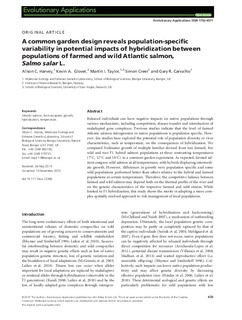A common garden design reveals population-specific variability in potential impacts of hybridization between populations of farmed and wild Atlantic salmon, Salmo salar L.
| dc.contributor.author | Harvey, Alison C. | |
| dc.contributor.author | Glover, Kevin | |
| dc.contributor.author | Taylor, Martin I. | |
| dc.contributor.author | Creer, Simon | |
| dc.contributor.author | Carvalho, Gary R. | |
| dc.date.accessioned | 2016-08-24T12:08:20Z | |
| dc.date.accessioned | 2016-09-21T11:32:36Z | |
| dc.date.available | 2016-08-24T12:08:20Z | |
| dc.date.available | 2016-09-21T11:32:36Z | |
| dc.date.issued | 2016-01-27 | |
| dc.identifier.citation | Evolutionary Applications 2016, 9(3):435-449 | nb_NO |
| dc.identifier.issn | 1752-4571 | |
| dc.identifier.uri | http://hdl.handle.net/11250/2409257 | |
| dc.description | - | nb_NO |
| dc.description.abstract | Released individuals can have negative impacts on native populations through various mechanisms, including competition, disease transfer and introduction of maladapted gene complexes. Previous studies indicate that the level of farmed Atlantic salmon introgression in native populations is population specific. However, few studies have explored the potential role of population diversity or river characteristics, such as temperature, on the consequences of hybridization. We compared freshwater growth of multiple families derived from two farmed, five wild and two F1 hybrid salmon populations at three contrasting temperatures (7°C, 12°C and 16°C) in a common garden experiment. As expected, farmed salmon outgrew wild salmon at all temperatures, with hybrids displaying intermediate growth. However, differences in growth were population specific and some wild populations performed better than others relative to the hybrid and farmed populations at certain temperatures. Therefore, the competitive balance between farmed and wild salmon may depend both on the thermal profile of the river and on the genetic characteristics of the respective farmed and wild strains. While limited to F1 hybridization, this study shows the merits in adopting a more complex spatially resolved approach to risk management of local populations. | nb_NO |
| dc.language.iso | eng | nb_NO |
| dc.publisher | Wiley | nb_NO |
| dc.rights | Navngivelse 3.0 Norge | * |
| dc.rights.uri | http://creativecommons.org/licenses/by/3.0/no/ | * |
| dc.title | A common garden design reveals population-specific variability in potential impacts of hybridization between populations of farmed and wild Atlantic salmon, Salmo salar L. | nb_NO |
| dc.type | Journal article | nb_NO |
| dc.type | Peer reviewed | nb_NO |
| dc.date.updated | 2016-08-24T12:08:20Z | |
| dc.source.pagenumber | 435-449 | nb_NO |
| dc.source.volume | 9 | nb_NO |
| dc.source.journal | Evolutionary Applications | nb_NO |
| dc.source.issue | 3 | nb_NO |
| dc.identifier.doi | 10.1111/eva.12346 | |
| dc.identifier.cristin | 1369067 | |
| dc.relation.project | EU/311920 | nb_NO |
Files in this item
This item appears in the following Collection(s)
-
Articles [3001]
-
Publikasjoner fra CRIStin [3025]

